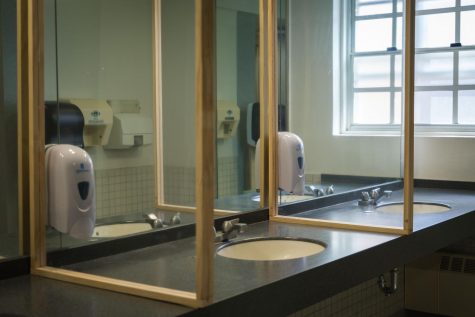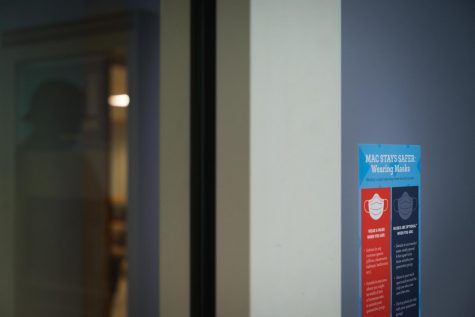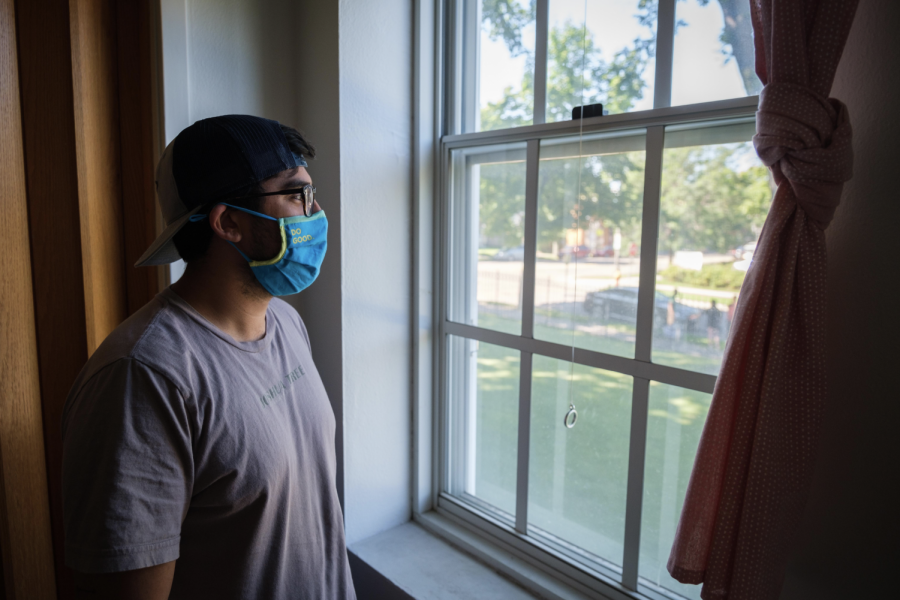Residential Life builds socially-distanced community
Residence Hall Director Jonathan Cardenas poses for a portrait in the residential life office of Bigelow Hall on August 18, 2020. Outside, residential assistants are arriving to move in for the 2020-2021 school year. Photo by Kori Suzuki ’21.
November 19, 2020
From athletics to academics to dining, Macalester community members have had to rethink many of the ways we navigate campus this semester as the COVID-19 pandemic sweeps the country. For Residential Life, a department still entirely based on campus, this has proved especially challenging.
This semester, only about 700 students are living on campus, in comparison to over 1200 in a typical year. The lower capacity allows every student to have their own room — ordinarily most students share, with first-years living with random roommates.
Along with this adjustment comes new safety rules and regulations aimed to mitigate the spread of COVID-19. Macalester’s community commitment limits the number of people who can be in a dorm room or a lounge and asks students to keep their social lives to small groups with physical distance.
Julia Coelho ’23, a resident assistant (RA) in Doty Hall, said the responsibilities of her position look a lot different this year.
“COVID has added additional duties such as looking out for COVID misconducts and making sure lounges are not exceeding maximum occupancy, and that we’re keeping the maximum number of people in a dorm no more than two,” Coelho said.
The makeup of the dorms looks different this year, too. Athletes are all living with teammates in Kirk Hall instead of spread out across campus. Many sophomores, juniors and seniors who had planned to live in the dorms made plans to live off-campus due to limited availability of rooms.
These efforts to minimize students in the dorms, and to limit their interactions with each other, are essential in ensuring the safety of on-campus students. However, a lot of these directly counteract traditional community building efforts on campus.
Assistant Dean for Residential Life Coco Du said that the pandemic has changed how RAs and residence hall directors (RHDs) work to foster connections in their living communities.
“The person-to-person connection, we feel, is just different prior to the pandemic,” Du said. “The challenge is, with public health safety, not letting that become a barrier to building social connections and community connections.”
Restrictions due to the pandemic have forced Residential Life staff to reimagine what social life in the dorms looks like. Usually, RAs and RHDs use a “community learning model” to plan residence hall programming, like meetings, intentional conversations and casual events.
That model is still at the center of Residential Life’s programming, but the programming has had to change this year.
Jonathan Cardenas, the RHD for 30 Mac, Bigelow, Wallace Hall and the Cultural House, said that Residential Life has continued to offer opportunities for students to get to know each other and build community. Residential Life staff have focused on planning some virtual and outdoor events to give students a chance to socialize.
“A lot of the things that we do this year just changed in the way we approach those strategies,” Cardenas said. “We’re having to do a lot of creative thinking around community building because… you’re by yourself by design.”

Cardenas noted that RAs and RHDs have found some creative ways around limitations on social events.
“We’re living in a new world right now, a lot of the stuff we do is really easy to just do over Zoom,” said Anna Švercl Hetzer ’23, an RA in Kirk Hall. “A lot of the work is thinking of new creative ideas to elevate the student experience while still maintaining social distance.”
Švercl Hetzer has had several successful asynchronous community engagement events such as group painting, where they simply left art supplies in the lounge and let students come by and use them on their own time
“I think people are getting really tired of computer-based tasks and assignments and everything starts to feel like work,” Švercl Hetzer said. “And so I feel like one of the biggest goals for me is when I do community engagement is finding creative solutions to make people more comfortable.”
The module system also allowed Residential Life to welcome additional students back to campus partway through the semester. For Module 2, about 50 new students moved onto campus. With the small group of newcomers, move-in weekend was relatively quiet.
But the new students are joining a campus that has already had a chance to quickly form COVID pods. Coelho said those groups can be tough to break into, both socially and for health reasons.
“I think because of COVID, the first group of students found groups of friends that they felt safe with because they were like, if we don’t do this soon, then we will just be lonely,” Coelho said. “With the additional students I am nervous that they will feel more alienated… because everyone else has already found their people, and I plan to focus on that a lot more for my new residents.”
With social distancing still imperative for public health, social isolation and loneliness continue to pose a challenge for many students living on-campus. In navigating the rest of this unpredictable school year, Residential Life plans to continue to develop ways to foster on-campus community.

“A lot of people that I’ve talked to are just grateful to be here at all,” Švercl Hetzer said.
“Since we don’t know a world in college without COVID… we’re used to it. And people are finding ways around it.”
“Isolation, in some ways, students are capable of feeling even in a non-COVID world, so knowing the exact differences is hard,” Cardenas said. “Students have talked about it, but it’s always within a conversation of how they are addressing it.”
In addition to Residential Life efforts, Cardenas said he’s seen students getting creative with how they interact. Virtual games like Among Us, Zoom calls and outdoor hangouts in pods have all been popular this semester.
“I’m learning about ways that people are connecting digitally… that really are designed to counteract some of the isolation that people may feel, and I think our community building goes a long way into that too,” Cardenas said. “If you feel isolated, I think it’s always encouraged to go outside and try to connect distanced so you can at least see somebody.”













